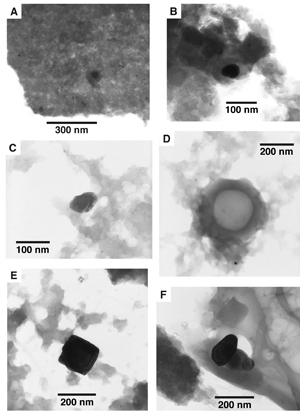| Sun | Mon | Tue | Wed | Thu | Fri | Sat |
|---|---|---|---|---|---|---|
| 1 | 2 | 3 | 4 | 5 | ||
| 6 | 7 | 8 | 9 | 10 | 11 | 12 |
| 13 | 14 | 15 | 16 | 17 | 18 | 19 |
| 20 | 21 | 22 | 23 | 24 | 25 | 26 |
| 27 | 28 | 29 | 30 | 31 |
CATEGORIES
RECENT ENTRIES
BLOG ROLL
Dust more valuable than gold
Cosmochemist Nicolas Dauphas discovered his gold-mounted meteorite grains contained evidence of a supernova 4.5 billion years old.
In 1848 a lumber mill worker in California spotted a tiny trace of a very valuable mineral, a discovery that sped the development of a continent. Last year, a U of C scientist in California spotted a really tiny trace of an almost non-existant mineral, a discovery that has shed light on the development of the solar system itself.
 There may be no rush on chromium 54, but cosmochemist and geophysics professor Nicholas Dauphas's recently published discovery of the mineral in nano-sized meteorite particles is even more valuable than gold: it is the first physical proof that a supernova occurred in our neck of the universe, an event that could have kick-started the birth of the sun and the solar system, around 4.5 billion years ago.
There may be no rush on chromium 54, but cosmochemist and geophysics professor Nicholas Dauphas's recently published discovery of the mineral in nano-sized meteorite particles is even more valuable than gold: it is the first physical proof that a supernova occurred in our neck of the universe, an event that could have kick-started the birth of the sun and the solar system, around 4.5 billion years ago.
Chromium 54 is an isotope of the element that is formed in nature only when stars explode. While scientists have speculated that such a supernova led to the creation of our sun (supernovae can be nurseries for new stars; they also lead to black holes), there was no direct proof that one had occurred. The presence on earth of chromium 54 changes all that. "It's the first time that we have solid grains in our laboratories," Dauphas said.
Moreover, since the isotope isn't spread out evenly through the solar system, which it would do if the solar system were formed when the event took place, it seems that it predates its birth, when the formation of the sun gathered the interstellar dust into the star and the eight planets (sorry, Pluto).
Dauphas called the process that led to the discovery "a fishing expedition." He and the team he'd assembled spent three weeks at Caltech painstakingly analyzing 1,500 particles with electron microscopes, each particle about 100 nanometers wide — so small, they're actually mounted on gold, for easy examination. To compare, the smallest thing visible to the naked eye is 50,000 nanometers.
(I got to see the box the gold ingots are kept in when I interviewed Dauphas. You know the awe you feel when walking among the dusty ruins of 5,000-year-old civilizations? This was waaay better than that.)
"People have been looking at these grains for a while using various means," said Dauphas, referring to other scientists and other, similar grains. He credited his team's success, published in the September 10 Astrophysical Journal, to recent refinements in using ion microprobes, only looking at similarly sized specimens, and a sense that the team had a historic problem to take on. "We had a strategy to tackle the question," he said, and "people who are on top of their game."
It was something Dauphas had wanted to do since 2002—the year he became a Enrico Fermi Institute research associate—but he hadn't had a chance until a five-month sabbatical in 2009. He took his samples to Caltech, where he'd managed to secure three weeks for the search, but it wasn't easy. Towards the end of the last session only one grain had tested positive for chromium, and without the confirmation of a second discovery, the team was getting disillusioned, worried they were on a wild goose chase. He told one colleague on his way back to his hotel, "If you find the grain, please call me, no matter what."
Not only did they find a second grain that tested positive for chromium 54, the specimen shone far brighter than the first.
(By the way, the 150-year-old meteorite the grains came from is called "Orgueil" and was already a pretty significant bit of science with a fascinating history.)
Asher Klein, '11
September 20, 2010
